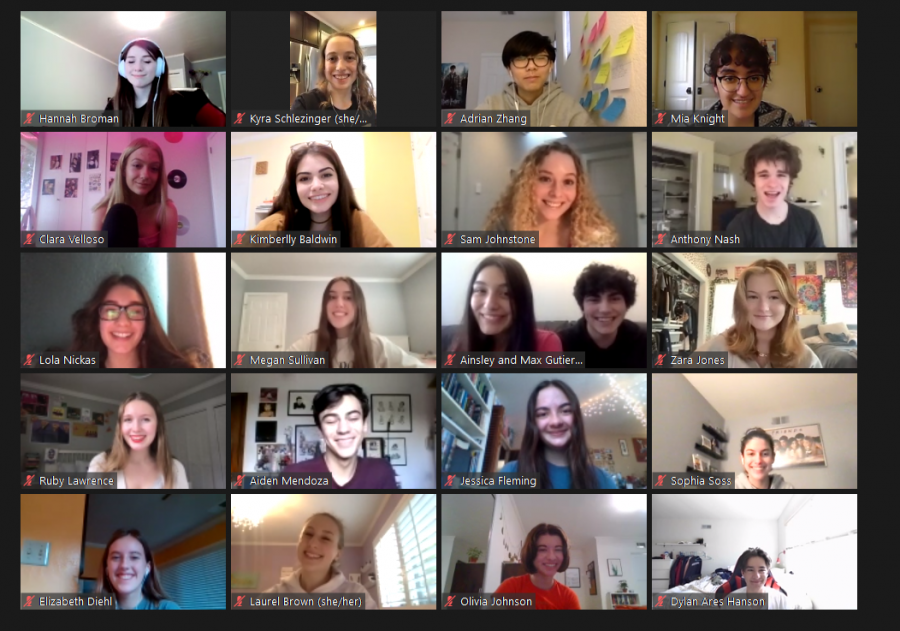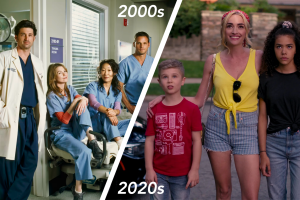The work behind virtual musical “Working”
Photo courtesy of Cindy Skelton
The cast and crew of the spring musical “Working” pose for a photo before discussing logistics at their Feb. 19 rehearsal.
March 1, 2021
Approaching the milestone of a year since COVID-19 hit the United States , theater has accordingly also had nearly a year to experiment with virtual performance. Following the success of Burlingame’s thespians in the online fall one-acts — “Help Desk” and “Bad Auditions… On Camera” — drama teacher Cindy Skelton decided to follow Burlingame’s tradition of a spring musical in an untraditional virtual format with “Working.” Performances will air on May 7, 8 and 9 on the website showtx4u.com, rather than on Zoom as Skelton arranged for the fall one-acts. Skelton credits this change to the meticulous audio engineering required for satisfactory vocal quality.
“You really can’t sing live [on Zoom]. It’s pretty much impossible, and you definitely can’t harmonize or have people singing in groups all at the same time,” Skelton said. “Each of my cast members is going to have to record themselves singing, like in a closet, basically, and then we’re going to film them doing the dance, and then we’re going to edit the voice on top of the video. It’s just a better quality vocally.”
The change in vocal routines is one of many shifts taking place in the production of “Working.” The BHS Panther Theater group was recently granted approval for outdoor, distanced choreography rehearsals on campus, which will be led by Jim Ambler. The in-person dance rehearsals are a step towards normalcy, but the bulk of rehearsals will still take place on Zoom. With virtual performances, the actors are not afforded the luxury of a present crew team to conduct technical aspects of the show, lighting and makeup, therefore, all 16 participating actors will take on new responsibilities.
“Each [actor] has to organize their own lighting and their costumes and, you know, their makeup, so they have to figure all that out. I mean, [the crew] will help them, of course, working with Zoom and everything, and figuring out what lighting is best. But, you know, a lot of it is up to them, so they have a lot more responsibility besides learning their lines,” stage manager Hannah Broman said.
As stage manager, Broman communicates with the cast about cues and call times and oversees smaller crew departments such as lighting, hair and makeup — where she started in her first production. The seven total crew members on “Working” is an increase from the two who worked on the fall one-acts. Learning from the successes and downfalls of her first virtual production, Broman will re-implement a Discord server for cast and crew that will allow them to efficiently communicate cues and inform actors of what props, setting and costumes to use and when. Props and some costuming are provided by the Drama Boosters, and virtual backgrounds will be chosen carefully for each scene.
Putting together a virtual production is no easy task but Skelton appreciates the broad audience that has resulted from easily accessible online performances. Despite the appeal of this increased audience, Skelton misses the perks of in-person theater.
“I miss going to live theater … There’s something magical about an actor — actors — sharing a story on stage and really pulling you into that story. Live theater is just so important, and sharing those moments with everybody else in the audience, just the sheer amount of rehearsal and energy and effort put into that performance, there’s nothing that can replace that,” Skelton, who has worked on 17 Burlingame theater productions prior, said.
There is hope for a return to in-person theater in the fall of 2021, but for now, Zoom rehearsals, and incredibly intricate audio and video editing, are the new abnormal.










































